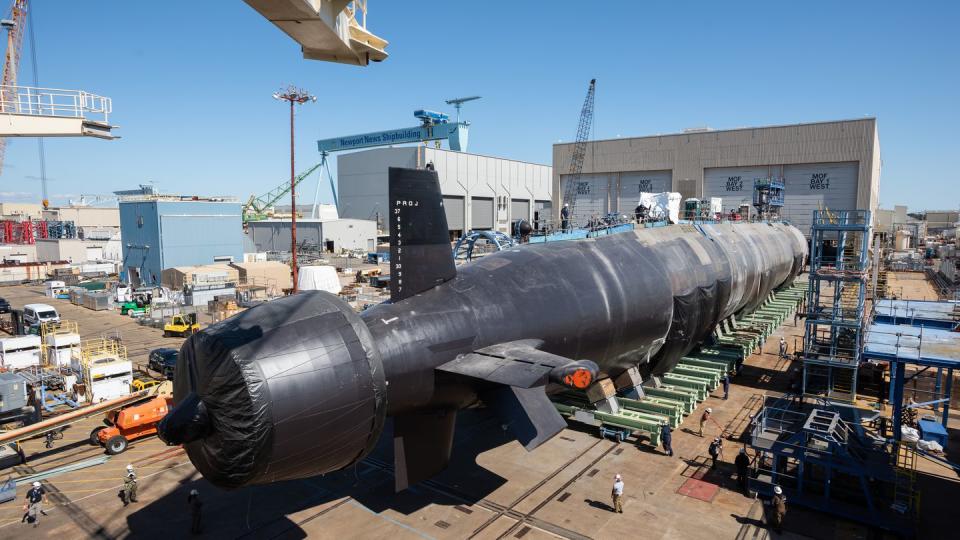Lawmakers worried Navy’s ongoing sub spending hasn’t fixed fleet woes
- Oops!Something went wrong.Please try again later.
WASHINGTON — As the government’s spending on the submarine industrial base grows, so too is concern among lawmakers.
The Biden administration’s recent supplemental spending request includes $3.4 billion for the submarine industrial base, which, if passed, would bring the total planned investment to $8.7 billion from the U.S. government from fiscal years 2017 to 2028. The Australian government, too, may pitch in an additional $3 billion to cover the increased workload as part of the trilateral submarine agreement with the United Kingdom and Australia, known as AUKUS.
Through this spending, the Navy now says it will dig out of an attack submarine maintenance backlog by late FY27 or early FY28. It has said it would get back to on-time attack sub deliveries by FY28 as well.
But even then, the Navy’s fleet will still be some 16 boats short of its stated requirement, with no construction capacity to increase the size of that fleet for at least another decade.
During a Wednesday hearing of the House Armed Services seapower and projection forces subcommittee, Rep. John Garamendi, D-Calif., questioned why the Navy needs more money to address the same submarine challenges discussed in hearings for years.
Noting new House Speaker Rep. Mike Johnson, R-La., in remarks Wednesday discussed reducing the deficit and cutting programmatic spending, Garamendi warned it may be hard to continue pouring more money into these same problems.
“Now, we can go on and on — but I won’t — about how long you have known there is a problem in the submarine section of the Department of Defense. In fact, everything that’s on this list has, frankly, been known for a long time, and using AUKUS as the reason for this new supplemental is, in part, in my view, disingenuous,” the California lawmaker said.
Vice Adm. William Houston, the commander of Naval Submarine Forces, said at the hearing the spending to date has made a difference. Since May, he said, the Navy’s in-service submarine fleet has gone from a 60% operational availability rate to 66% and is on track to reach the expected 80% operational availability rate by late FY27 or early FY28, assuming the submarine industrial base investments.
The supplemental bill includes about $700 million for parts, infrastructure and more needed for submarine repairs.
Rear Adm. Jonathan Rucker, the Program Executive Officer for Attack Submarines, said at the hearing about $2 billion of the $3.4 billion would go to supplier development, strategic outsourcing — an initiative to allow outside companies to build massive sections of the submarine in a bid to alleviate pressure on shipbuilders General Dynamics’ Electric Boat and HII’s Newport News Shipbuilding — and workforce expansion and development.
Following spending in FY19 and FY20, he said, more than 20 companies now are doing large structural fabrication work to support strategic outsourcing.
“We’re at about 4 million man hours annually that we’ve now pushed out,” Rucker said. “Our goal is to get up over 6 million by 2025.”
Rep. Rob Wittman, R-Va., said he’s concerned Electric Boat and Newport News Shipbuilding won’t be able to hire and retain more workers. He said the two added 4,855 tradesmen in 2022, but lost 3,384. This year, he said, they added 7,193 through September but lost 3,313.
“We can throw all the money we want to at the problem, but if you don’t have the people there in the yards to build these submarines, I don’t care what else we do, this enterprise fails,” Wittman said.
Rucker said the two yards have increased the radius from which they’re trying to hire, including going into largely Hispanic communities outside their previous hiring areas. Rucker said Electric Boat raised salaries at its Quonset Point yard in Rhode Island last fall and has since reported an improved hiring rate.

Despite these efforts and the billions of money spent and still to come, the fleet is set to continue shrinking in size. A long-range shipbuilding plan shows the fleet at 50 attack submarines this year, dipping to 46 in FY30, and then rising back to 50 in FY34 — against a requirement for 66 attack submarines, based on the Navy’s study of its operational needs.
The Navy could have a chance to grow the size of the attack submarine fleet, but it’s about a decade away. The service is currently buying a Virginia-class submarine with an extra Virginia Payload Module section, which adds to the workload. Those boats will finish construction in the early 2030s, according to Rep. Joe Courtney, D-Conn., whose district includes the Electric Boat yard.
“When we go back to the regular Virginia-class submarines, that’s actually going to create capacity just by itself,” he said.
The Navy will also buy its last Columbia-class ballistic missile submarine in FY35. The Columbia sub is about 2.5 times bigger than a Virginia and has strained the industrial base. When the Columbia buys end, Navy leaders have said there may be room in the budget and at the shipyards to increase how many Virginias the Navy buys each year.
Courtney is seeking to make the Navy’s case for additional investment and has released several memos to fellow lawmakers with details about the submarine industrial base’s improvements to date and, most recently, an explanation of what the supplemental spending request would provide.

